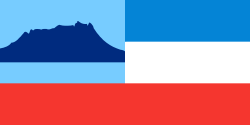Kedayan
Kedayan| Total population |
|---|
|
Est. 240,000 in Borneo[1] |
| Regions with significant populations |
|---|
|
 Brunei Brunei
 Malaysia Malaysia
Sarawak (Lawas, Limbang, Miri)
Sabah (Sipitang, Beaufort, Kuala Penyu, Papar)
Labuan |
| Languages |
|---|
|
Malay, Bruneian, English, Brunei English |
| Religion |
|---|
|
Shafi'i Sunni Muslim |
| Related ethnic groups |
|---|
|
Demographics of Brunei, Bruneian, Malay |
The Kedayan (also known as Kadayan, Kadaian or Kadyan)[1] are an ethnic group residing in Brunei, Labuan, Sabah, and parts of Sarawak on the island of Borneo.[2][3] The Kedayan language (ISO 639-3: kxd) is the de facto national language of Brunei and has a similarities with the Brunei Malay, which spoken by more than 130,000 people in Brunei, 46,500 in Sabah and 37,000 in Sarawak.[4][5][6] In Sabah, the Kedayan are mainly live in Sipitang, Beaufort, Kuala Penyu and Papar.[4][7] While in Sarawak, the Kedayans are mostly reside in Lawas, Limbang, Miri and Sibuti area.[4]
History
The origins of Kedayans are somewhat uncertain, with some of them belief that their people originated from Java,[2] in which they came during the reign of Bolkiah. Due to the famed of the Sultan as a sea captain and voyager, he became known to the peoples of Java, Sumatra and the Philippines.[2] It is believed when the Sultan anchored in the island of Java, he became interested with the agricultural techniques adopted there.[2] So, the Sultan brought some of this Javanese farmers back to his country to adopted the techniques in which later they interact and inter-married with the local Bruneian Malay peoples and produce the Kedayan ethnic.[2] Now, most of the Kedayans are Muslim and has accepting Islam since the Islamic era of the Sultanate of Brunei and adopted the Malay culture into their lives.[6] The Kedayan are recognised as one of the indigenous people of Borneo,[8] and were professionals in making of traditional medicines which also has a reputation for knowledge in medicinal plants, in which they grow to treat a wide range of ailments or to make tonics.[4]
An indigenous people in Kutai, Kalimantan were also said having more than 90% similarity with Kedayan language even though they did not called themselves as Kedayan. Both the Kedayan and Banjarese is sometimes been related in the term of language.
See also
References
- ↑ 1.0 1.1 Mokhtar, R. A. M.; Sa‟Ari, C. Z. (2014). "A Preliminary Study on Factors That Lead Muslim Kedayan to Continue Performing the Syncretic Culture". International Journal of Social Science and Humanity 4 (6): 421. doi:10.7763/IJSSH.2014.V4.391.
- ↑ 2.0 2.1 2.2 2.3 2.4 Ahmad Ibrahim; Sharon Siddique; Yasmin Hussain (1985). Readings on Islam in Southeast Asia. Institute of Southeast Asian Studies. pp. 312–. ISBN 978-9971-988-08-1.
- ↑ James Alexander (2006). Malaysia, Brunei and Singapore. New Holland Publishers. pp. 367–. ISBN 978-1-86011-309-3.
- ↑ 4.0 4.1 4.2 4.3 Shiv Shanker Tiwary & P.S. Choudhary (1 January 2009). Encyclopaedia Of Southeast Asia And Its Tribes (Set Of 3 Vols.). Anmol Publications Pvt. Ltd. ISBN 978-81-261-3837-1.
- ↑ Michael Zanko; Matt Ngui (1 January 2003). The Handbook of Human Resource Management Policies and Practices in Asia-Pacific Economies. Edward Elgar Pub. pp. 10–. ISBN 978-1-84064-751-8.
- ↑ 6.0 6.1 A. Suresh Canagarajah (15 January 2005). Reclaiming the Local in Language Policy and Practice. Routledge. pp. 227–. ISBN 978-1-135-62351-7.
- ↑ Julie K. King; John Wayne King (1984). Languages of Sabah: Survey Report. Department of Linguistics, Research School of Pacific Studies, Australian National University. ISBN 978-0-85883-297-8.
- ↑ Carl Skutsch (7 November 2013). Encyclopedia of the World's Minorities. Routledge. pp. 781–. ISBN 978-1-135-19388-1.
| Related articles |
|---|
|  Recognised ethnic groups in Labuan |
|---|
| | Ethnic groups | |
|---|
|
 Recognised ethnic groups in Sabah |
|---|
| | Ethnic groups | |
|---|
|
 Recognised ethnic groups in Sarawak |
|---|
| | Ethnic groups | |
|---|
|
|
|